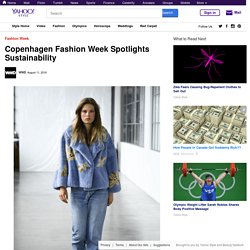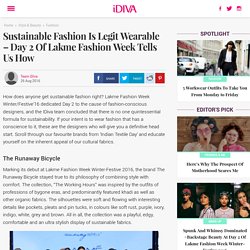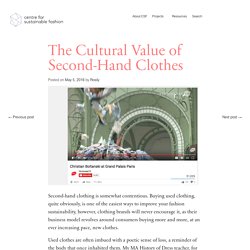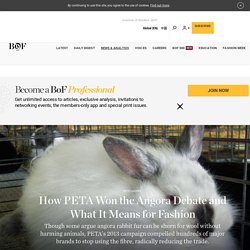

What Sustainability Means To The Millennial Generation. Jo Godden, Founder of RubyMoon, discusses how brands can limit their environmental impact worldwide According to Goldman Sachs, there are around 92 million millennials in the US currently, making them the largest demographic in American history so far.

Critically, they are also set to be the most important consumer group yet, with estimates of annual spending projected at around $200 billion by 2017, and $10 trillion over their lifetimes as consumers. With these figures comes the all-important question of how business can best cater to this multi-faceted millennial marketplace—the real questions being what do they value? And therefore, what do they want to spend their money on?
The question points us back to sustainability. Recent studies indicate that millennials have a new, insistent consumer appetite that is colored distinctly green. However, the main problem facing these pioneering brands is gaining consumer exposure. This is why the revolution must begin at the top. H&M on Conscious Materials. Copenhagen Fashion Week Spotlights Sustainability. Copenhagen Fashion Week, which began Wednesday and runs through Friday, is giving sustainability some good play.

The event held in the wake of the Copenhagen Fashion Summit, which drew 1,250 industry delegates last May, had sustainable label Fonnesbech on its first day — Crown Princess Mary of Denmark sat front row at the Fonnesbech display — and two Swedish brands with a sustainability perspective on day two: House of Dagmar and Uniforms For The Dedicated, two newcomers to the Copenhagen calendar. “The vision is the gap that Copenhagen could fill: to take the position as the sustainability destination and bring together the brands from all over the world who want to work on sustainability,” said Eva Kruse, chief executive officer of Copenhagen Fashion Week, noting that she would like H&M to reveal its Conscious Collection during Copenhagen Fashion Week, as well as draw such players as Stella McCartney and Prada, who both have an ethical point of view in terms of production.
Sustainable Fashion Is Legit Wearable – Day 2 Of Lakme Fashion Week Tells Us How. How does anyone get sustainable fashion right?

Lakme Fashion Week Winter/Festive’16 dedicated Day 2 to the cause of fashion-conscious designers, and the IDiva team concluded that there is no one quintessential formula for sustainability. If your intent is to wear fashion that has a conscience to it, these are the designers who will give you a definitive head start. Scroll through our favourite brands from ‘Indian Textile Day’ and educate yourself on the inherent appeal of our cultural fabrics. The Runaway Bicycle Marking its debut at Lakme Fashion Week Winter-Festive 2016, the brand The Runaway Bicycle stayed true to its philosophy of combining style with comfort. For P.E.L.L.A, sustainability is not restricted to fabrics. Padmaja It was in Maheshwar, Madhya Pradesh that Padmaja Krishnan created the woven fabric used in this collection.
Greenpeace Announce the Stars of Their Detox Catwalk 2016. The Cultural Value of Second-Hand Clothes. Second-hand clothing is somewhat contentious.

Buying used clothing, quite obviously, is one of the easiest ways to improve your fashion sustainability, however, clothing brands will never encourage it, as their business model revolves around consumers buying more and more, at an ever increasing pace, new clothes. Used clothes are often imbued with a poetic sense of loss, a reminder of the body that once inhabited them. My MA History of Dress teacher, for example, admitted that she couldn’t bring herself to wear second-hand clothes because they felt like ghosts of the previous owners, still marked and affected by the body that used to wear them. She is an amazing teacher, but, I fundamentally disagree with her stance on second-hand clothes. I remember sitting in class, listening to these views wearing a blue and white striped jumper that was handed down to me, second-hand, by a sixty-something-year-old, yoga-doing, campervan-driving hippie from the town I grew up in in America.
How PETA Won the Angora Debate and What It Means for Fashion. NEW YORK, United States — In the spring of 2016, a group of top-tier fashion executives convened in midtown Manhattan for a closed-door meeting.

The conversation centred on the treatment of animals and the ethics policies they had in place. It was clear that many brands felt more pressure than ever to cooperate with the People for the Ethical Treatment of Animals — the international non-profit organisation widely known as PETA. “Look at what PETA did to angora,” one executive said. “They virtually wiped it out.” Indeed, in 2013, PETA took on the trade in angora rabbit fur in what proved to be one of its most successful campaigns, releasing a video of a rabbit in China — the world's top producer of angora wool — being tortured and mutilated, its fur hand-plucked from its body. Indeed, sales of angora rabbit wool — not to be confused with the fleece of the angora goat, also known as mohair — have decreased dramatically since PETA launched its campaign. Related Stories: Met Gala 2016: Emma Watson wears a Calvin Klein dress made from recycled plastic bottles.